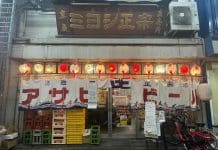After 15 years in prison, former yakuza hitman Noriyuki Kunihiro, known to his old friends as Kuni (Yoshio Harada) is back in Osaka’s Shin Sekai area. The area in the south of the city dominated by the Tsutenkaku Tower, surrounded by many traditional Osaka eateries and quite a few seedy entertainment spots. A yakuza hotspot, according to the movies.
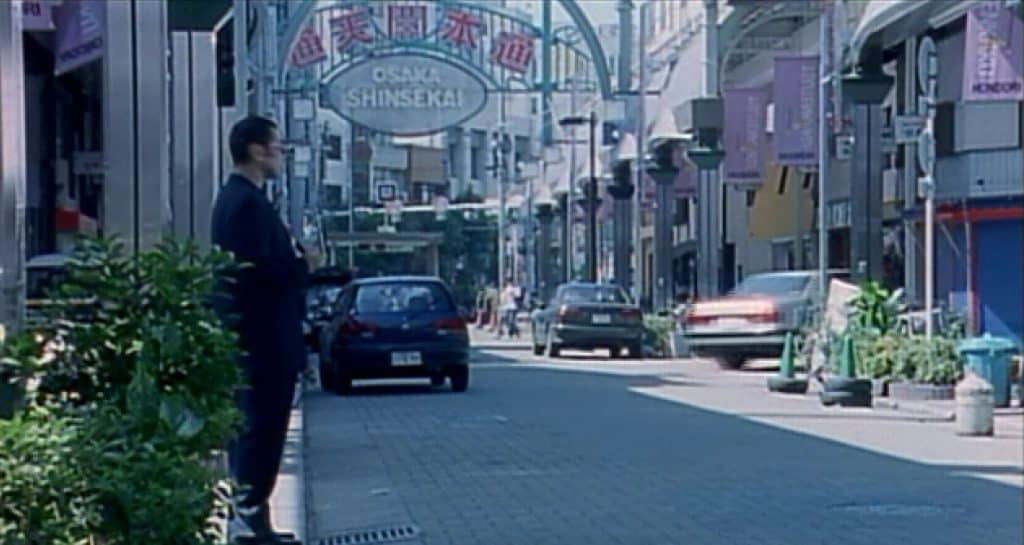
Those 15 years were not his first time in prison, all in all he had already spent 27 years in the slammer, half his life. By now, he’s had enough of the gang life and the resulting prison sentences. He wants to go straight.
But rather than trying to start a new life in, say, a remote fishing village on the opposite coast, Kuni returns to his old stomping grounds in Shin Sekai.
The Shin Sekai yakuza consider him to be an old-time yakuza hero, a true yakuza of a time gone by. They value him for his dedication to the gang, for the way he used to handle things. They want him back.
Soon after his arrival back in Shin Sekai, his old friend Tanigawa (Sho Aikawa) meets up with him. They head to a small kushikatsu eatery. Kushikatsu is a very traditional Osaka food, deep-fried minced meat and vegetables on a stick. While Kuni is refusing Tanigawa’s offer to re-join the gang, he double-dips his kushikatsu-stick into the sauce. That’s an absolute no-no at any Osaka joint. After taking a bite from your stick, you never dip it into the common sauce pool again. Witnessing such a breach of etiquette, the bartender yells at Kuni, “Don’t double-dip!” Kuni throws his whole kushikatsu stick into the sauce pool, then fishes it out with his fingers. Only a hardened yakuza would dare to do such a thing.

That’s a key scene setting the tone for the course of the movie. Prison life hasn’t broken Kuni’s rebellious spirit. He does whatever he wants – and he makes it clear to everyone that the rules of polite society don’t apply to him. Kuni, the taciturn loner, living by his own rules.
Finally, Tanigawa offers Kuni a deal. He could be the driver of the gang boss. He wouldn’t have to join the gang for that but he would be close, somewhat. Kuni agrees.
Kuni moves into the house of Sakata (Kazuki Kitamura), a former prison cellmate who has sworn off any future crime. Sakata is an effeminate homosexual. Kuni has no problem with that.
The scenes of Kuni flunking driving school are pure comedy. He doesn’t care, he becomes the boss’s driver without a license.
The job as driver sometimes requires him to solve problems his old yakuza ways. In a way, he is in with the old gang again but not quite.
One night, at a hooker bar, Kuni drunkenly brags about the killings he did way past to the assembled yakuza and the girls-for-hire.
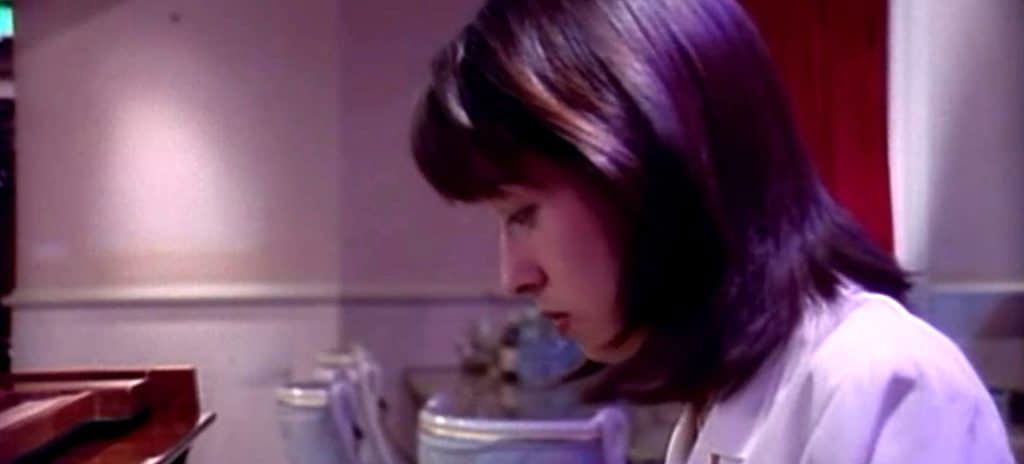
When Tanigawa asks him, “Which girl do you want to take home?”, Kuni replies with “The one at the piano.” The cute piano player playing classical pieces (Reiko Kataoka). She’s not one of the hookers, she’s just a part-time piano player. But when the madam of the house asks her about the proposal, she just cooly says, “A million yen and I will do it.” Tanigawa accepts the price readily. It’s the gang that pays for Kuni’s pleasure.
Table of Contents
Onibi – The fire within (Japan, 1997) 鬼火
Kuni and Asako, the piano player, soon begin to like each other, in a rather vague way. Their meeting could be the beginning of a love story. A love story that eventually takes Kuni away from the yakuza.
Instead, Asako asks Kuni for a gun. She needs to kill someone. A bad guy named Fujimi, a guy who did horrible things to her sister. That sister does not exist. Asako has very personal reasons to take revenge on Fujimi (played by Ryuchi Yamamoto).

Fujimi, as bad a guy as he is, is not a yakuza. But his brother is one of the top yakuza bosses of Shin Sekai. Upon learning what Asako and Kuni did to his brother, he soon demands a tough response by Kuni’s old gang. Finger-cutting will not do this time.
The title
Onibi – The Fire Within is the English language release title for the film. In Japanese, the title is only Onibi 鬼火, referring to ghost lights appearing in Japanese legends. In many cases phosphorous lights appearing in swamps at night, leading the late evening wanderer looking for a place to stay ever deeper into the swamp.
Arthouse Yakuza Movie
Onibi, based on an original screenplay by native Osaka screen writer Toshiyuki Morioka (born in 1960) feels like an arthouse movie disguised as a genre flick. Sure, there is plenty of realistic-looking violence but the film is much more focused on the inner feelings of Kuni, nicknamed Fire Ball by the local yakuza, than on the violence as such.
Kuni is quite a conflicted character. He can go into a pointless rage when losing a game of shogi, he can be very caring once calmed down. He prepares great okonomiyaki (Osaka style Japanese pancakes), he refuses the large sums offered by his old gang. But when it comes to what he considers the appropriate revenge, he strictly follows the old gang codes he learned in his youth. He can never admit defeat and if one of his friends is murdered, he musty revenge him, no matter what. Even if it means that he will spend the rest of his life in prison… or heads to the gallows.
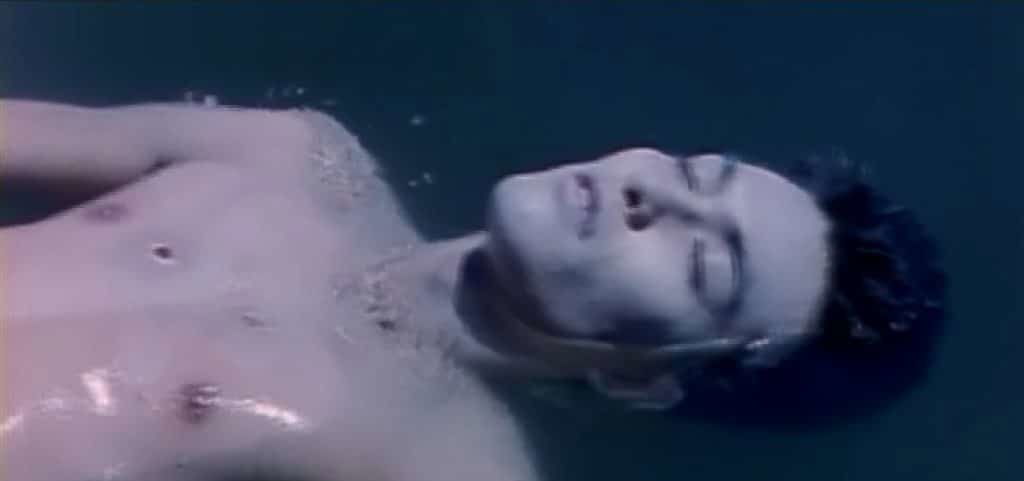
The movie also goes into quite some detail featuring the internal dealings of the yakuza. There are different gangs involved and they all follow a strict code of business. Gang wars are the last thing they want. They all want to make money. So, if one member of one gang did something bad to a member of another gang, the boss of the victim’s gang would show up at the headquarters of the other gang and ask for suitable retribution. Punish the guy for his bad behavior, pay a fee and we will be on good terms again.
The gang bosses are ruthless businessmen and they will crash down hard on any chimpira (apprentice member) in their own ranks whose reckless actions might put relations with other gangs in danger.
Unscrupulous business-minded gang leaders, an emotionally conflicted Kuni and a girl out for personal revenge… it’s a recipe for disaster.
The Director: Rokuro Mochizuki
Director Rokuro Mochizuki won the award for Best Director at the 1998 Yokohama Film Festival for Onibi.
Mochizuki, born in Tokyo in 1957, studied film at Image Forum in Tokyo, an organization dedicated to avant-garde and independent film. Upon graduation, he joined Nikkatsu Studio and began working in the production of Roman Porno, the Nikkatsu line of pink films (Japanese sex films).
It was the 1980s and pink films went into decline, largely due to the emergence of Adult Video (AV), a genre Mochizuki soon embraced. Pink films were real films, telling stories and employing real actors, the sex scenes being staged. In Adult Video, on the other hand, the sex was real hardcore sex, with the pubic areas being pixeled out. Real actors were not required, anyone good looking and willing to have sex in front of the camera could become an AV performer. Still, AV soon developed its very own star system.
Mochizuki worked extensively in the world of AV before switching to mainstream movies in the early 1990s.
In the mid-to-late 1990s, Mochizuki directed a number of yakuza movies. Those films, Onibi being one of them, are generally considered Mochizuki’s best work.
Even while working on the yakuza movies, Mochizuki continued with the AV productions. He eventually fell back into the AV world full time in the early 2000s.
His last film to date, Johnen: Love of Sada, was released in 2008, an artistically ambitious Adult Video telling the story of an erotic photographer and his model.
Yoshio Harada and Reiko Kataoka

Kuni, the main character of Onibi is played by veteran actor Yoshio Harada (1940 – 2011). Harada, a native of Tokyo, started out playing youthful rebels in violent action films like Nikkatsu’s Alleycat Rock: Crazy Riders ’71. The main star of that movie was legendary actress Meiko Kaji and the film was made shortly before Nikkatsu turned producing to Roman Porno.
Harada kept up the image of the rough and gruff outsider over the years and movie directors loved him for that. Especially directors who aimed for unconventional movies with edgy characters in the lead. Directors like Seijun Suzuki, Koji Wakamatsu and avant-garde theater / movie maverick Shuji Terayama.
The Internet Movie Database (IMDb) lists 145 movies with Yoshio Harada.
At the 1989 Yokohama Film Festival, Yoshio Harada won the prize for Best Actor for Onibi.
Harada’s female counterpart in Onibi is Reiko Kataoka. Kataoka, born in Ehime Prefecture, Shikoku in 1971 had her first big screen appearance in the 1995 crime action film Kamikaze Taxi (director Masato Harada).
It was her performance as Asako in Onibi that provided her with her real breakthrough. At the 1998 Yokohama Film Festival, she won the prize for Best Supporting Actress for Onibi.
Reiko Kataoka is still very busy as an actress in Japanese movies today.
Osaka Locations
Shin Sekai is front and center in the movie. Early in the movie, Tanigawa spots Kuni in a small park with Tsutenkaku Tower clearly in view. They then head to the kushikatsu restaurant, another staple of the neighborhood.
While kushikatsu is served all over Osaka, Shin Sekai is arguably home to the most traditional kushikatsu restaurants, mostly very tiny hole-in-the-wall eateries. Kuni’s breach of eating etiquette takes place inside such a tiny traditional joint.
When Kuni and Tanigawa part way after the meal, they do so in front of a large sign announcing the Osaka Shin Sekai tourist visitor area.
Tanigawa offers Kuni an envelope with a large amount of money. Kuni refuses the money but asks Tanigawa for his new digital photo camera. Camera in hand, Kuni walks through the neighborhood and does some snaps. Including an image of Tsutenkaku Tower sideways.
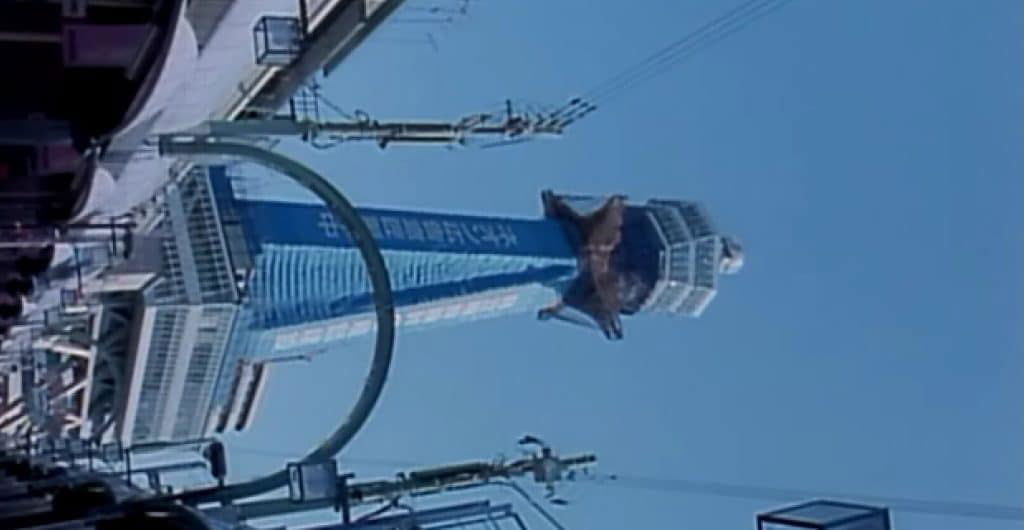
Soon after, Kuni rides the train to Shin Imamiya Station (actually in close walking distance from Shin Sekai).
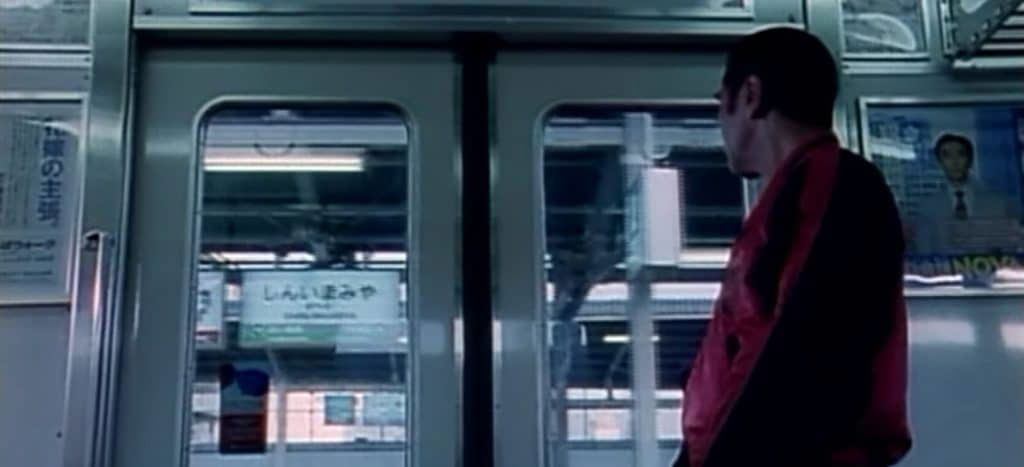
After Kuni leaves, the camera remains on the train and offers fleeting images of the Airin Labor Welfare Center in Kamagasaki, located right next to the elevated train tracks. Large crowds can be spotted sitting outside the huge building complex. Those are actual images of the homeless populating Kamagasaki. Only someone knowing that part of “deep Osaka” would recognize the images as such, though.
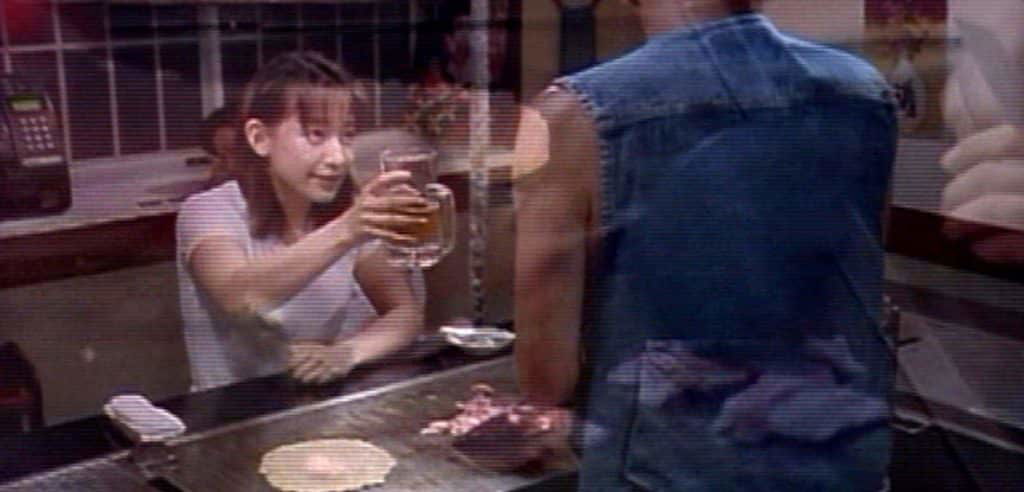
In the build-up to the final bloodshed of the movie, Kuni lovingly prepares okonomiyaki for Asako. Okonomiyaki, sometimes called Japanese pancakes, are another typical Osaka dish, usually prepared on a teppan, a large heated metal plate covering the center of the table in an okonomiyaki restaurant. Customers cook the dish by themselves, the restaurant provides the raw mix of ingredients.
The movie rarely ventures out of Shin Sekai at all. Aside from the rural graveyard in the opening scene and a few shots of Osaka Dome, the famous baseball stadium opened to the public in the same year the movie was released, 1997.
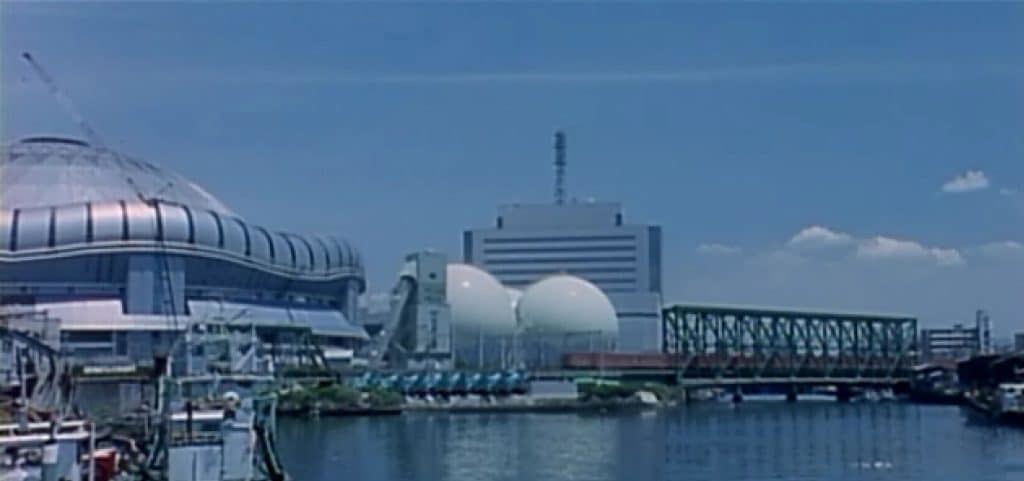
Osaka Dome, located in Nishi Ward, is a few kilometers away from Shin Sekai. Still, it’s in the southern part of Osaka and only a few stops by train from the center of activity featured in the movie.






